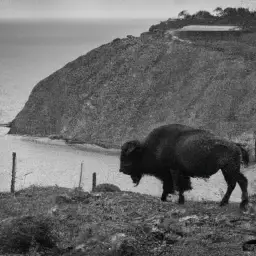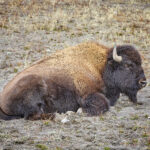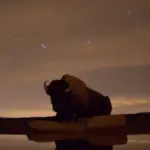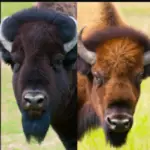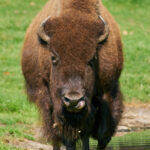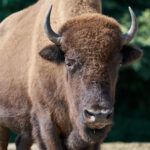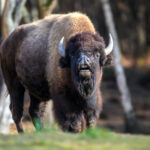Have you ever wondered why there are bison on Catalina Island? It’s a unique phenomenon that continues to fascinate locals and visitors alike. In this article, we will delve into the intriguing history behind this unexpected presence of bison on an island off the coast of California. Discover the surprising reasons behind their arrival, the challenges they face in this unusual habitat, and the efforts being made to preserve their existence. Join us on this captivating journey to uncover the mysteries of Catalina Island’s bison population.
History of Bison on Catalina Island
Arrival of Bison on the Island
The history of bison on Catalina Island dates back to 1924 when fourteen bison were brought to the island for the filming of a silent movie called “The Vanishing American.” Although the film industry initially introduced the bison to the island, their presence quickly became more than just a cinematic spectacle.
The Role of the Film Industry
The film industry played a significant role in the introduction of the bison to Catalina Island. The picturesque landscapes of the island provided an ideal backdrop for countless movies, attracting filmmakers from far and wide. The bison were intended to add an authentic touch to the Western films that were popular during that time. However, after the movie shootings ceased, the bison were left to freely roam the island, unknowingly altering its ecology forever.
Popularity with Tourists
Over the years, the bison on Catalina Island became a beloved attraction for tourists. Visitors were enchanted by the sight of these majestic creatures roaming freely amid the island’s picturesque surroundings. The bison’s unique presence added an element of wilderness and adventure, captivating the hearts of those who set foot on the island. As word spread about the bison, more and more tourists flocked to Catalina Island to catch a glimpse of these impressive animals in their natural habitat.
Biological Impact of Bison on the Island
Effects on Native Flora and Fauna
The introduction of bison to Catalina Island had a profound impact on the island’s native flora and fauna. With their overwhelming grazing habits, bison exerted substantial pressure on the island’s vegetation. Native plants, unaccustomed to such intense grazing, struggled to regenerate and maintain their populations. As a result, certain plant species experienced decline, which subsequently impacted other dependent organisms in the ecosystem.
Ecosystem Disruptions
The arrival of bison disrupted the delicate balance of Catalina Island’s ecosystem. As the bison grazed extensively on the island’s plant life, the availability of food for other herbivorous species dwindled. This imbalance had ripple effects throughout the food chain, affecting the populations of various animals, including birds and small mammals. The repercussions of these disruptions extended to the island’s soil composition and nutrient cycles, leading to further ecological alterations.
Piños Paloverde Savannah Ecosystem
One of the most severely affected ecosystems on Catalina Island is the Piños Paloverde savannah. This unique ecosystem, characterized by its arid conditions and distinctive vegetation, suffered greatly due to the presence of bison. Native plant species like the Catalina Ironwood struggled to regenerate and thrive amidst extensive grazing pressure from the bison. The disruption of this ecosystem threatened the biodiversity and ecological integrity of the island.
Current Population of Bison
Population Control Methods
To manage the burgeoning bison population on Catalina Island, population control methods have been implemented. These methods, overseen by the Catalina Island Conservancy, aim to regulate the number of bison to minimize their ecological impact. The bison population is monitored regularly, and birth control measures have been introduced to limit reproduction rates. These population control efforts are crucial to maintaining the delicate balance of the island’s ecosystem while ensuring the welfare of the bison herd.
Winter Feed and Health Check-ups
During harsh winter months when food becomes scarce, the Catalina Island Conservancy implements a supplemental feeding program for the bison. This initiative ensures that the herd receives adequate nutrition during challenging times and helps prevent overgrazing of native vegetation. Furthermore, health check-ups are conducted regularly to monitor the well-being of the bison and provide necessary veterinary care when required.
Breeding Patterns
The breeding patterns of bison on Catalina Island are carefully managed to prevent uncontrolled population growth. Specific breeding seasons are designated to limit the number of offspring and maintain a stable population size. By controlling breeding, the Catalina Island Conservancy can avoid overcrowding and mitigate the ecological impact that an unrestrained population could have on the island.
Challenges with Bison Co-habitation
Human and Bison Interactions
The cohabitation of humans and bison on Catalina Island has presented unique challenges over the years. Visitors and residents alike can find themselves in close proximity to these large animals, leading to potential safety concerns. However, extensive education and awareness programs have been implemented to promote responsible human-bison interactions, ensuring the safety of both parties involved.
Conflicts and Resolutions
Conflicts between bison and humans occasionally arise due to misunderstandings and vulnerabilities associated with close encounters. Instances of bison charging or displaying aggressive behavior have been reported, highlighting the need for cautious interaction. To address these conflicts, guidelines and regulations have been established to minimize negative encounters and promote a harmonious coexistence between humans and bison.
Policy and Regulation
The Catalina Island Conservancy plays a crucial role in implementing policies and regulating the interactions between humans and bison. Strict guidelines are in place to safeguard the welfare of the animals and ensure the safety of the visitors. These regulations help strike a balance between the protection of the island’s unique ecosystem and the preservation of the bison as a cherished tourist attraction.
Bison as Tourist Attraction
Revenue from Bison Related Tourism
The presence of bison on Catalina Island has significantly contributed to the tourism industry on the island. Visitors from all over the world are drawn to the island to witness these magnificent creatures in their natural environment. The revenue generated from bison-related tourism, including guided tours and educational programs, has had a positive impact on the local economy. This economic boost enables the Catalina Island Conservancy to continue its conservation efforts and promote the sustainable coexistence of bison and humans.
Promotion and Advertising
Tourism organizations on Catalina Island actively promote the bison as one of the island’s top attractions. Through various marketing campaigns, visitors are enticed to experience the beauty and wonder of observing these iconic animals up close. Social media platforms and travel websites also play a vital role in spreading the word about the unique opportunity to witness bison roaming freely amidst the island’s breathtaking landscapes.
Tourist Reactions and Experiences
Tourists’ reactions to encountering bison on Catalina Island are overwhelmingly positive. Excitement and awe radiate from visitors as they witness these powerful animals, often capturing memorable photographs and stories to share with family and friends. The experience of observing bison in their natural habitat fosters a deeper appreciation for wildlife conservation and ecotourism. This interaction with nature leaves a lasting impact on visitors and fosters a sense of responsibility towards the preservation of these magnificent creatures and their habitat.
Bison Conservation Efforts
Role of Conservation Programs
Conservation programs led by the Catalina Island Conservancy have been instrumental in the protection and preservation of the bison population on Catalina Island. These programs focus on monitoring population numbers, managing vegetation to support biodiversity, and preventing the overgrazing of native flora. The conservation efforts also involve educational initiatives that raise awareness about the ecological impact of bison and promote responsible tourism practices.
Aid from Outside Organizations
The conservation efforts on Catalina Island have received support from various outside organizations dedicated to wildlife preservation. Collaboration with these organizations has facilitated the exchange of knowledge and resources, enabling the implementation of effective conservation strategies. Through fundraising initiatives and joint research projects, the Catalina Island Conservancy continues to benefit from the aid of these organizations, ensuring the long-term sustainability of the bison population.
Effectiveness of Conservation Efforts
The conservation efforts undertaken on Catalina Island have proven to be remarkably effective in managing the bison population and mitigating their ecological impact. By carefully monitoring the population, implementing population control methods, and promoting responsible human interactions, the island has managed to strike a balance between conserving the unique ecosystem and maintaining the bison as a prized attraction. Continuous research and adaptive management strategies further enhance the effectiveness of the conservation efforts, providing valuable insights for the continued coexistence of bison and the island’s delicate ecology.
Understanding Bison Behavior
Bison Habits and Patterns
Understanding the behavior of bison is essential for their successful conservation and management on Catalina Island. Bison are migratory by nature and form social hierarchies within their herds. They exhibit grazing behavior and require diverse habitats to meet their nutritional needs. Being aware of these habits and patterns helps guide conservation efforts and ensure the availability of suitable habitats for the bison to thrive.
Interaction with other Species
Bison have a fascinating interaction with other species on Catalina Island. Their grazing behavior creates open spaces in the vegetation, providing opportunities for smaller animals to thrive. Certain bird species are known to frequent bison grazing areas, benefiting from the insects and seeds exposed by their grazing activities. This interdependence between bison and other species highlights the importance of biodiversity in maintaining a healthy ecosystem.
Adaptation to Island’s Climate and Environment
The bison on Catalina Island have showcased remarkable adaptability to the island’s unique climate and environment. Originating from the plains of North America, they have successfully adapted to the Mediterranean climate and rugged landscapes of the island. Their ability to withstand harsh conditions and utilize available food resources has contributed to their survival and proliferation. Catalina Island’s bison population serves as a living example of how wildlife can adapt and thrive in diverse environments.
Ecological Role of Bison
Contribution to Biodiversity
Bison play a significant role in enhancing biodiversity on Catalina Island. By creating open areas through their grazing activities, bison facilitate the growth and expansion of various plant species. These open spaces harbor an array of insects and small mammals, attracting different bird species to the ecosystem. This rich diversity strengthens the resilience of the island’s flora and fauna, contributing to the overall biodiversity of Catalina Island.
Impact on Soil and Vegetation
The grazing habits of bison have a profound impact on the soil and vegetation of Catalina Island. By selectively grazing on certain plant species, bison influence the composition and distribution of the island’s vegetation. This, in turn, affects soil characteristics, nutrient cycles, and water dynamics. The bison’s grazing activities promote the growth of new plants, enrich soil fertility, and shape the overall structure of the island’s vegetation.
Role within the Food Web
Bison occupy a crucial position within the food web of Catalina Island. As herbivores, they consume vast quantities of plant material, shaping the availability and abundance of resources for other species. The open spaces created by bison grazing provide ideal habitats for insects, small mammals, and birds. Predators such as coyotes and foxes also benefit indirectly from the bison’s presence, as the availability of prey increases. The bison’s role as a primary consumer influences the dynamics and interactions within the island’s intricate food web.
Bison Health Concerns
Common Diseases and Health Risks
Like any wildlife population, the bison on Catalina Island face common diseases and health risks. Parasitic infections, such as ticks and internal parasites, pose significant health concerns for the herd. Injuries sustained during confrontations within the herd or interactions with humans can also impact the bison’s health. Efforts to mitigate disease transmission and provide necessary veterinary care are crucial to maintaining the overall health and vitality of the bison population.
Veterinary Care for the Herd
The Catalina Island Conservancy works closely with veterinary professionals to provide comprehensive healthcare for the bison herd. Regular health check-ups, vaccinations, and treatments for parasites help keep the herd in optimal condition. Additionally, the conservation team collaborates with experts to conduct research and collect data on the bison population’s health, enabling proactive measures to minimize disease risks and maximize the herd’s well-being.
Impact of Health on Population
The health of the bison population directly affects its long-term survival and reproduction. A disease outbreak could have devastating consequences on the overall population, leading to a decline in numbers and genetic diversity. By prioritizing the health of the animals and addressing any emerging health concerns promptly, the Catalina Island Conservancy safeguards the continued existence and viability of the bison population on the island.
What is the Reason for Bison Population on Various Islands?
The bison population Antelope Island has thrived due to the availability of suitable habitat and food sources. Various islands provide isolated environments that protect the bison from predators and allow them to reproduce without significant threat. This has led to sustainable bison populations on these islands.
Future of Bison on Catalina Island
Projections on Population Growth
Projections indicate that the bison population on Catalina Island will continue to grow steadily. With effective management strategies in place, the population is expected to remain stable and sustainable. The implementation of birth control measures and continuous monitoring will help maintain a balance between the well-being of the bison and the island’s ecological integrity.
Potential Threats to Bison
While the bison population is currently thriving on Catalina Island, there are potential threats that need to be carefully managed. Infectious diseases, climate change, and habitat loss are important factors that may impact the long-term survival of the bison population. Vigilant monitoring, adaptive management strategies, and ongoing conservation efforts are vital in addressing these threats and ensuring the future of the bison on Catalina Island.
Role of Bison in Catalina Island’s Future
The bison have become an integral part of Catalina Island’s identity and future. Their presence not only contributes to the island’s biodiversity but also supports the local economy through tourism revenue. The conservation efforts aimed at maintaining a sustainable coexistence between bison, humans, and the island’s ecology demonstrate the commitment to preserve this unique heritage for generations to come. The bison’s role as ambassadors for wildlife conservation and ecological balance serves as a testament to their significance in shaping Catalina Island’s future.

